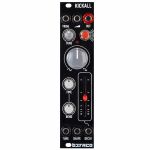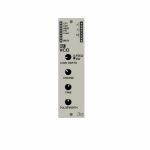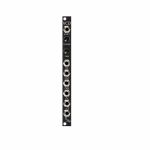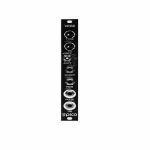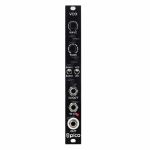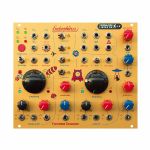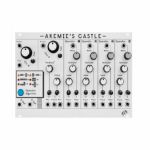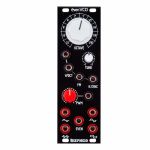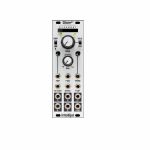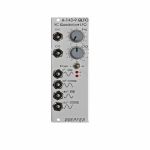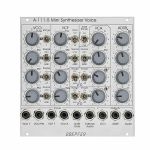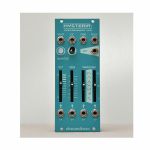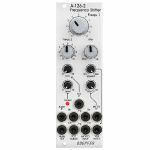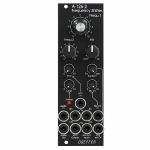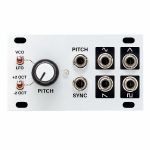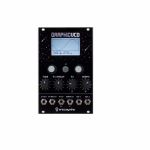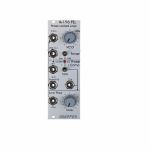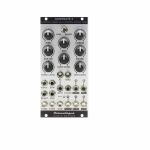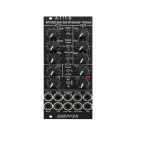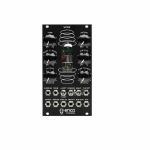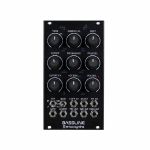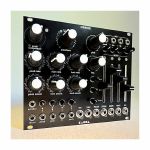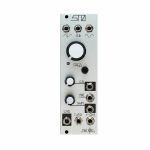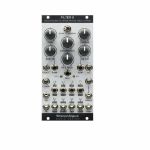100% Compra Segura
Studio equipment
Our full range of studio equipment from all the leading equipment and software brands. Guaranteed fast delivery and low prices.
100% Compra Segura
DJ equipment
Our full range of DJ equipment from all the leading equipment and software brands. Guaranteed fast delivery and low prices. Visit Juno DJ
Filter
Equipment
Format
Featured
Price
Studio Equipment charts
Bestselling Studio Equipment vinyl
Artículos del 1 al 26 de 26 en la página 1 de 1
Befaco Kickall Voltage Controlled Analogue Kick Drum Voice Module (drum/synth voice module)
Cat: 689669 Rel: 14 Feb 19
Punchy kick drum module - 6HP
Notes: Kickall is a 6HP compact synth voice that features everything needed to make a big fat Kick sound. A stable VCO that tracks V/Oct, a couple of VCAs, envelopes for volume and pitch and an aggressive waveshaper.
The module has been designed with a kick synthesis patch in mind.
The audio path consists of a sinewave oscillator that passes across a Square Waveshaper and two VCA's. The first VCA is for the Volume envelope. The second VCA is dedicated to general volume. Thanks to his CV input, it is possible o apply accents or affects the dynamics of notes. Feeding this input with audio generates a basic AM operation expanding the sonic range of the module.
In the control path, KickAll has two envelope circuits to modulate the first VCA oscillator's pitch. Both envelopes are fired at the same time manually or via dedicated trigger input.
Through its Tune input, KickAll tracks eight octaves with high accuracy. Plug your favourite sequencer or CV source to create patterns out of the kick range, or feed it with an audio signal, for frequency modulation Fx.
Specs
Current needs: +12V: 26mA, -12V: 12mA
Width: 6 HP
Depth: 20mm, (28mm DIY) including power connector
Aluminium, heat-treated front panel.
Designed, kits prepared and completed modules assembled in Barcelona.
… Read moreThe module has been designed with a kick synthesis patch in mind.
The audio path consists of a sinewave oscillator that passes across a Square Waveshaper and two VCA's. The first VCA is for the Volume envelope. The second VCA is dedicated to general volume. Thanks to his CV input, it is possible o apply accents or affects the dynamics of notes. Feeding this input with audio generates a basic AM operation expanding the sonic range of the module.
In the control path, KickAll has two envelope circuits to modulate the first VCA oscillator's pitch. Both envelopes are fired at the same time manually or via dedicated trigger input.
Through its Tune input, KickAll tracks eight octaves with high accuracy. Plug your favourite sequencer or CV source to create patterns out of the kick range, or feed it with an audio signal, for frequency modulation Fx.
Specs
Current needs: +12V: 26mA, -12V: 12mA
Width: 6 HP
Depth: 20mm, (28mm DIY) including power connector
Aluminium, heat-treated front panel.
Designed, kits prepared and completed modules assembled in Barcelona.
1 in stock $205.50
Click for better price!
or call +44 20 7424 1960
quote 689669
quote 689669
Tangible Waves AE Modular VCO Analogue Audio Oscillator Module (oscillator synth module)
Cat: 719693 Rel: 02 Sep 19
Analogue audio oscillator module
Notes: This module is best if you need an oscillator for primary musical / melodic use.? It offers:
- two CV inputs 1V/octave
- Modulation input with Level-knob, switchable to frequency or pulsewidth
- PWM input
- Coarse / Fine knob for frequency
- Pulsewidth knob for square wave
- Square / Triangle / Sawtooth output
… Read more- two CV inputs 1V/octave
- Modulation input with Level-knob, switchable to frequency or pulsewidth
- PWM input
- Coarse / Fine knob for frequency
- Pulsewidth knob for square wave
- Square / Triangle / Sawtooth output
1 in stock $49.81
Click for better price!
or call +44 20 7424 1960
quote 719693
quote 719693
2hp Sine Harmonically Pure VCO Module (black) (oscillator synth module)
Cat: 727389 Rel: 02 Oct 19
Digital oscillator module with sub output & wavefolding - black
Notes: Sine is a harmonically pure VCO with two distinct outputs.
The primary output contains a perfect sine wave with a wide frequency range and pristine volt per octave tracking. The Sub output features two sine tones that can be blended together to achieve a mix of one octave below, or a fifth above the primary output's frequency.
In addition, both outputs have an internal wavefolder that adds harmonic content to the signal allowing for spectrally complex tones within a single module. Keep your tones pure (or not!) with Sine.
… Read moreThe primary output contains a perfect sine wave with a wide frequency range and pristine volt per octave tracking. The Sub output features two sine tones that can be blended together to achieve a mix of one octave below, or a fifth above the primary output's frequency.
In addition, both outputs have an internal wavefolder that adds harmonic content to the signal allowing for spectrally complex tones within a single module. Keep your tones pure (or not!) with Sine.
1 in stock $143.22
Click for better price!
or call +44 20 7424 1960
quote 727389
quote 727389
Erica Synths Pico VCO 2 Analogue Voltage Controlled Oscillator Module (oscillator module)
Cat: 732841 Rel: 01 Apr 20
Analogue voltage controlled oscillator module in 3HP
Notes: Erica Synths Pico VCO 2 - powerful, full analogue VCO with great tracking over 8 octaves just in 3HP! Combine two of those, add some PWM and have a sound of real analogue beast!
Features:
Manual TUNE and PWM controls
+-1 octave switch
1V/oct input with good tracking across 8 octaves
PWM CV input
Pulse and triangle waveform outputs
Input protection against overvoltage
Protection against reverse PSU connection
Technical specification:
Output signal amplitude: -5V - +5
PWM CV input (full span): -5V - +5V
Power consumption: +21mA, -19mA
Module width: 3HP
Module depth: 35mm
… Read moreFeatures:
Manual TUNE and PWM controls
+-1 octave switch
1V/oct input with good tracking across 8 octaves
PWM CV input
Pulse and triangle waveform outputs
Input protection against overvoltage
Protection against reverse PSU connection
Technical specification:
Output signal amplitude: -5V - +5
PWM CV input (full span): -5V - +5V
Power consumption: +21mA, -19mA
Module width: 3HP
Module depth: 35mm
2 in stock $108.97
Click for better price!
or call +44 20 7424 1960
quote 732841
quote 732841
Erica Synths Pico VCO Digital Voltage Controlled Oscillator Module (oscillator/LFO module)
Cat: 686634 Rel: 30 Apr 18
Digital voltage controlled oscillator module - 3HP
Notes: Erica Synths Pico VCO is a great, deep sounding VCO with 32 selected waves: classical, fattened with sub-oscillator, FM synth and others.
Features
2 banks, 16 waves each
VCO/LFO mode
Voltage controlled wavesurfing
Wave morphing in LFO setting
Typically you would need several rather expensive modules to generate similar sounds, besides there's an extra feature: flip a switch, and you have a versatile LFO.
With Pico Series we challenged ourselves - can we make ANY superior functionality synth module 3HP wide and affordable? Yes, we can.
Technical specification:
VCO frequency range: 30Hz - 5kHz
LFO frequency range: 0,1Hz - 20Hz
1V/Oct input signal amplitude: 0V - +10V;
Output amplitude: 10V ptp
Power consumption: +26 mA, -4 mA
Module width: 3HP
Module depth: 35 mm
… Read moreFeatures
2 banks, 16 waves each
VCO/LFO mode
Voltage controlled wavesurfing
Wave morphing in LFO setting
Typically you would need several rather expensive modules to generate similar sounds, besides there's an extra feature: flip a switch, and you have a versatile LFO.
With Pico Series we challenged ourselves - can we make ANY superior functionality synth module 3HP wide and affordable? Yes, we can.
Technical specification:
VCO frequency range: 30Hz - 5kHz
LFO frequency range: 0,1Hz - 20Hz
1V/Oct input signal amplitude: 0V - +10V;
Output amplitude: 10V ptp
Power consumption: +26 mA, -4 mA
Module width: 3HP
Module depth: 35 mm
1 in stock $110.80
Click for better price!
or call +44 20 7424 1960
quote 686634
quote 686634
Endorphin.es Furthrrrr Generator Dual Complex VCO Module With Waveshaper (yellow) (oscillator/dual/stereo/function generator/LFO/noise/random module)
Cat: 579172 Rel: 07 Aug 15
Dual voltage controlled oscillator module with waveshaper module - 30HP
Notes: The Furthrrrr Generator has a main oscillator (carrier) with an extensive and fully voltage controllable wave multiplier and a modulation oscillator (modulator) that can cross-modulate the carrier. Each oscillator has hard and soft sync and also features an integrated tuner: if both LEDs are lit the VCO is at note A. Left LED is lit at note Ab and right LED at A#. Frequency potentiometers are ten-turn models and thus allow for easy tuning. Frequency range of the VCOs is 10Hz-10kHz (and much lower in modulator's LFO mode). Both VCOs feature 2 frequency CV inputs (1x with bipolar attenuator, 1x with 1V/octave), one FM input (jumper selectable between linear and exponential FM) as well as separate input for hard and soft sync. The voltage characteristic can be selected between 1V/octave and 1.2V/octave (Buchla norm).
The main oscillator (carrier) outputs the waveforms sine, saw, square and white noise. The two outputs marked with the magic eye are outputs of the "harmonic section" that generates very complex sounds by the wave multiplier and its parameters symmetry, order and Furthrrrr in the module's right-hand section. Symmetry lowers the level of even harmonics and amplifies the odd harmonics (this affects the pulse wave's width as well). Order adds saturation to the high order harmonics and resembles a low pass filter. Furthrrrr alters the level of harmonics set by the other parameters and produces very interesting, partly brute sounds with lots of harmonics by clipping and folding the wave. All three parameters can be voltage controlled. The carrier oscillator also has inputs for hard and soft sync, the sync-switch can synch directly to the modulator.
The modulation oscillator (modulator) has three wave forms with direct outputs: sine, saw and square. Using the internal modulation via the "mood section" the waveform is selected with a button; an additional staircase wave form is available here, but it can be overridden by inserting a signal into the external input socket. A switch activates the LFO mode.
The Mood section is responsible for the internal modulation of the carrier by the modulator. Switches determine the modulation destination(s) that can be activated simultaneously. These are the Furthrrrr parameter of the harmonic section, the amplitude and the frequency of the carrier oscillator. The "balanced" switch activates the ring modulation between both VCOs. intensity of modulation is controlled by the "mood index" potentiometer and the according CV input with bipolar attenuator.
… Read moreThe main oscillator (carrier) outputs the waveforms sine, saw, square and white noise. The two outputs marked with the magic eye are outputs of the "harmonic section" that generates very complex sounds by the wave multiplier and its parameters symmetry, order and Furthrrrr in the module's right-hand section. Symmetry lowers the level of even harmonics and amplifies the odd harmonics (this affects the pulse wave's width as well). Order adds saturation to the high order harmonics and resembles a low pass filter. Furthrrrr alters the level of harmonics set by the other parameters and produces very interesting, partly brute sounds with lots of harmonics by clipping and folding the wave. All three parameters can be voltage controlled. The carrier oscillator also has inputs for hard and soft sync, the sync-switch can synch directly to the modulator.
The modulation oscillator (modulator) has three wave forms with direct outputs: sine, saw and square. Using the internal modulation via the "mood section" the waveform is selected with a button; an additional staircase wave form is available here, but it can be overridden by inserting a signal into the external input socket. A switch activates the LFO mode.
The Mood section is responsible for the internal modulation of the carrier by the modulator. Switches determine the modulation destination(s) that can be activated simultaneously. These are the Furthrrrr parameter of the harmonic section, the amplitude and the frequency of the carrier oscillator. The "balanced" switch activates the ring modulation between both VCOs. intensity of modulation is controlled by the "mood index" potentiometer and the according CV input with bipolar attenuator.
2 in stock $604.06
Click for better price!
or call +44 20 7424 1960
quote 579172
quote 579172
ALM Akemie's Castle Dual 4 Operator FM VCO Module (oscillator synth module)
Cat: 584261 Rel: 15 Apr 16
Dual voltage controlled oscillator (VCO) synthesiser module with authentic 4 operator digital FM - 38HP wide
Notes: 'Akemie's Castle' is a dual voltage controlled oscillator with authentic 4 Operator digital FM using 'new-old-stock' Yamaha IC's for audio signal generation.
Each of the 4 operators feature independent waveform selection, frequency multiplier and level control via direct panel operation and voltage control. Operators can be combined in various ways across both oscillators, which together with independent feedback control on each VCO, offer an extremely wide palette of sounds.
Oscillator A also features a chord mode providing a range of up to 5 voice chords and voltage controlled inversion.
… Read moreEach of the 4 operators feature independent waveform selection, frequency multiplier and level control via direct panel operation and voltage control. Operators can be combined in various ways across both oscillators, which together with independent feedback control on each VCO, offer an extremely wide palette of sounds.
Oscillator A also features a chord mode providing a range of up to 5 voice chords and voltage controlled inversion.
2 in stock $481.59
Befaco Even VCO High Precision VCO Module With Octave Selector (oscillator module)
Cat: 668582 Rel: 09 Nov 17
High precision VCO module with octave select - 8HP
Notes: The EVEN VCO is a voltage-controlled oscillator that offers stability and high precision tuning over 10 octaves. A redesigned temperature compensation circuit maintains the oscillator stable against voltage and temperature drops.
Specifications:
Current needs: +12V: 36mA, -12V: 26mA
Width: 8 HP
Depth: 22mm, (28mm DIY) including power connector
Aluminium, heat-treated front panel.
Designed, kits prepared and completed modules assembled in Barcelona.
… Read moreSpecifications:
Current needs: +12V: 36mA, -12V: 26mA
Width: 8 HP
Depth: 22mm, (28mm DIY) including power connector
Aluminium, heat-treated front panel.
Designed, kits prepared and completed modules assembled in Barcelona.
1 in stock $159.52
Intellijel Dixie II+ Triangle Core VCO & LFO Module (silver) (LFO/ocillator synth module)
Cat: 602195 Rel: 10 Aug 16
Full featured VCO/LFO synth module - 8HP wide
Notes: Full-featured triangle core VCO/LFO
The Dixie II+ is a larger variant of the classic Dixie II. Using the same great triangle core oscillator, it adds a number of features to make it even more versatile with only a modest increase in size. The Dixie II+ makes a great primary oscillator for a modular system, or a great companion the Rubicon.
… Read moreThe Dixie II+ is a larger variant of the classic Dixie II. Using the same great triangle core oscillator, it adds a number of features to make it even more versatile with only a modest increase in size. The Dixie II+ makes a great primary oscillator for a modular system, or a great companion the Rubicon.
1 in stock $212.77
Doepfer A-143-9 QLFO Voltage Controlled Quadrature LFO & VCO Module (oscillator/LFO synth module)
Cat: 738640 Rel: 09 Jul 19
Voltage controlled sine-LFO with four separate, phase shifted outputs - 8HP
Notes: Module A-143-9 is a derivative of our planned thru-zero quadrature VCO. It is a voltage controlled sine LFO with 4 outputs. The phase shift between the outputs is 90 degrees. The sine shifted by 90 degrees is also called cosine, the sine shifted by 180 degrees is nothing but the inverted sine, and the sine by 90 degrees is nothing but the inverted cosine.
The frequency range is from some minutes to frequencies beyond audio with three ranges selected by a toggle switch:
- Switch position H: about 30 Hz ... 3.5 kHz with the manual frequency control ("Frq."), beyond 20 kHz with additional external CV
- Switch position M: about 1 Hz ... 150 Hz with the manual frequency control ("Frq.")
- Switch position L: about 0,1 Hz ... 10 Hz with the manual frequency control ("Frq."), down to several minutes with additional external CV
Two exponential frequency control inputs are available: CV1 without attenuator and CV2 with polarizer. Consequently the module can be used even as an experimental sine VCO but does not feature an exact 1V/oct CV input! The precision CV input will be left to the thru-zero quadrature VCO.
Two LEDs display the positive and negative share of the sine output.
The core of the module is a so-called quadrature circuit that generates a sine a cosine signal with very low distortion. The quality of the sine/cosine signals are much better than those generated by a waveform converter with a sawtooth or triangle signal as starting point.
The output levels are about 5 Vss (+/-2.5V) but can be adjusted internally by a trimming potentiometer (P5 "Shape").
Typical applications:
- External sine/cosine oscillator for the frequency shifter A-126
- Modulations with pure sine/cosine waveforms
- Quadrature/barberpole effects (e.g. with the voltage controlled mixer A-135)
- Experimental sine/cosine VCO (e.g. for FM sounds)
Many users suggested to add a common output level control, i.e. four VCAs with one common control (manual + CV without attenuator + CV with polarizer) for the output levels. This is why we also designed the Quad VCA module A-132-2 with the possibility of an internal default connection to the four outputs of the A-143-9 (no soldering required, short 10 pin flat cable with removable connectors on both ends).
The A-143-9 is also a meaningful addition for the Frequency Shifter module A-126. It enables frequency shifting even below 50 Hz generating e.g. these mellow beat sounds with a few Hz frequency shifting only. The following document describes how to connect the A-126 and the A-143-9: A126_A143_connection.pdf.
The thru zero version of the A-143-9 with temperature compensation is the module A-110-4.
… Read moreThe frequency range is from some minutes to frequencies beyond audio with three ranges selected by a toggle switch:
- Switch position H: about 30 Hz ... 3.5 kHz with the manual frequency control ("Frq."), beyond 20 kHz with additional external CV
- Switch position M: about 1 Hz ... 150 Hz with the manual frequency control ("Frq.")
- Switch position L: about 0,1 Hz ... 10 Hz with the manual frequency control ("Frq."), down to several minutes with additional external CV
Two exponential frequency control inputs are available: CV1 without attenuator and CV2 with polarizer. Consequently the module can be used even as an experimental sine VCO but does not feature an exact 1V/oct CV input! The precision CV input will be left to the thru-zero quadrature VCO.
Two LEDs display the positive and negative share of the sine output.
The core of the module is a so-called quadrature circuit that generates a sine a cosine signal with very low distortion. The quality of the sine/cosine signals are much better than those generated by a waveform converter with a sawtooth or triangle signal as starting point.
The output levels are about 5 Vss (+/-2.5V) but can be adjusted internally by a trimming potentiometer (P5 "Shape").
Typical applications:
- External sine/cosine oscillator for the frequency shifter A-126
- Modulations with pure sine/cosine waveforms
- Quadrature/barberpole effects (e.g. with the voltage controlled mixer A-135)
- Experimental sine/cosine VCO (e.g. for FM sounds)
Many users suggested to add a common output level control, i.e. four VCAs with one common control (manual + CV without attenuator + CV with polarizer) for the output levels. This is why we also designed the Quad VCA module A-132-2 with the possibility of an internal default connection to the four outputs of the A-143-9 (no soldering required, short 10 pin flat cable with removable connectors on both ends).
The A-143-9 is also a meaningful addition for the Frequency Shifter module A-126. It enables frequency shifting even below 50 Hz generating e.g. these mellow beat sounds with a few Hz frequency shifting only. The following document describes how to connect the A-126 and the A-143-9: A126_A143_connection.pdf.
The thru zero version of the A-143-9 with temperature compensation is the module A-110-4.
1 in stock $75.02
Doepfer A-111-5 Mini Synthesiser Voice Module (silver) (envelope generator/filter/LFO/oscillator/VCA/synth voice synth module)
Cat: 785445 Rel: 10 Sep 20
A complete monophonic synthesiser module (modular version of Dark Energy).
Notes: A fully modular, Eurorack-format version of the excellent Dark Energy synth, the A-111-5 offers VCO, VCF, LFOs, VCA and envelope generator in a compact format. Brilliant value for a starter system.
Supplier's Notes:
Module A-111-5 is a complete monophonic synthesizer module that includes these components (modular version of Dark Energy):
VCO
Manual tune control (with an internal jumper the range can be set to ~ +/-1 half an octave or ~ +/-2.5 octaves)
Range switch -1 / 0 / +1 octave
Frequency range about 10Hz ... 12kHz - FM (frequency modulation) control with modulation source switch (LFO1 / off / ADSR)
Manual pulsewidth control for rectangle waveform
PWM control with modulation source switch (LFO2 / off / ADSR)
Waveform switch (sawtooth / off / triangle)
The sum of the waveform chosen by this switch and the rectangle is fed into the VCF (to turn the rectangle off the PW control has to be set fully CCW)
External CV input for VCO frequency (1V/octave)
External CV input for external PWM of the rectangle - internal CV input for frequency (1V/octave) connected to the A-100 bus via jumper, the jumper can be used to interrupt this internal connection if not wanted
VCF
24 dB low pass
~ 12 octaves frequency range
Manual frequency control
Tracking switch half - off - full (internally connected to the external frequency CV input of the VCO, i.e. the VCF tracks to the VCO if the switch is set to "half" or "full" position)
XM: exponential FM (frequency modulation) control with modulation source switch (LFO2 / off / ADSR)
LM: linear FM (frequency modulation) control to modulate the VCF by the triangle of the VCO in a linear (!) manner
Manual resonance control (up to self oscillation)
External audio input (this signal is added to the VCO signal)
External CV input for filter frequency - 1V/octave tracking for usage of the VCF as a sine wave oscillator (not as precise as the VCO but much better than most of the other filters)
VCA
Manual amplitude control
AM (amplitude modulation) control with modulation source switch (LFO1 / off / ADSR)
External CV input for VCA amplitude - special control scale: exponential scale in the range from about -20dB to -80/90dB, linear scale from about -20dB to 0dB (Remark: this special control scale results in a loudness behaviour that is a bit different from pure linear or exponential VCA)
LFO1 and LFO2
Manual frequency control
Waveform switch (triangle / off / rectangle)
Range switch (low, audio, medium) - LED display (dual green/red color for positive/negative share of the signal)
The inverted LFO1 signal is available as an additional socket (to use the LFO1 signal for external modules)
An internal jumper can be used to select between the LFO1 signal or the inverted LFO1 signal
ADSR
Manual controls for Attack, Decay, Sustain, Release
Range switch (long, short, medium) - blue LED display
ADSR signal is available as an additional socket (to use the ADSR signal for external modules)
Gate input connected to the A-100 bus via jumper, the jumper can be used to interrupt this internal connection if not wanted
Remarks:
As the LFO frequencies can go up to moderate audio range (~ 5kHz) even audio FM effects of VCO (pitch and pulsewidth), VCF and ADSR are possible.
If the VCO is turned off (waveform switch = center position, pulsewidth control = fully CCW) and the VCF resonance is set to maximum the module can be used as a sine oscillator. The sine can be modulated in a linear manner from the triangle wave of the VCO and by LFO2 in an exponential manner at the same time !
From the factory the socket labelled "LFO1" outputs the inverted LFO1 signal. But as the module has several internal pin headers available even another signal may appear at this socket by changing the internal module patch. These six pin headers are available: LFO1 output, LFO2 output, ADSR output, inverter input, inverter output, output socket. The internal default patch is LFO1 -> inverter input, inverter output -> output socket (i.e. socket = inverted LFO1). But even another signal can be patched to this socket (e.g. inverted ADSR, non-inverted LFO1, inverted or non-inverted LFO2). It is also possible to add a blind panel next to the A-111-5 with a couple of sockets that are connected to the corresponding pins of the A-111-5 pc board. The in- and outputs of the VCO, VCF and VCA are not available as pin headers because the VCO, VCF and VCA are internally connected in the circuit which is used in this module.
… Read moreSupplier's Notes:
Module A-111-5 is a complete monophonic synthesizer module that includes these components (modular version of Dark Energy):
VCO
Manual tune control (with an internal jumper the range can be set to ~ +/-1 half an octave or ~ +/-2.5 octaves)
Range switch -1 / 0 / +1 octave
Frequency range about 10Hz ... 12kHz - FM (frequency modulation) control with modulation source switch (LFO1 / off / ADSR)
Manual pulsewidth control for rectangle waveform
PWM control with modulation source switch (LFO2 / off / ADSR)
Waveform switch (sawtooth / off / triangle)
The sum of the waveform chosen by this switch and the rectangle is fed into the VCF (to turn the rectangle off the PW control has to be set fully CCW)
External CV input for VCO frequency (1V/octave)
External CV input for external PWM of the rectangle - internal CV input for frequency (1V/octave) connected to the A-100 bus via jumper, the jumper can be used to interrupt this internal connection if not wanted
VCF
24 dB low pass
~ 12 octaves frequency range
Manual frequency control
Tracking switch half - off - full (internally connected to the external frequency CV input of the VCO, i.e. the VCF tracks to the VCO if the switch is set to "half" or "full" position)
XM: exponential FM (frequency modulation) control with modulation source switch (LFO2 / off / ADSR)
LM: linear FM (frequency modulation) control to modulate the VCF by the triangle of the VCO in a linear (!) manner
Manual resonance control (up to self oscillation)
External audio input (this signal is added to the VCO signal)
External CV input for filter frequency - 1V/octave tracking for usage of the VCF as a sine wave oscillator (not as precise as the VCO but much better than most of the other filters)
VCA
Manual amplitude control
AM (amplitude modulation) control with modulation source switch (LFO1 / off / ADSR)
External CV input for VCA amplitude - special control scale: exponential scale in the range from about -20dB to -80/90dB, linear scale from about -20dB to 0dB (Remark: this special control scale results in a loudness behaviour that is a bit different from pure linear or exponential VCA)
LFO1 and LFO2
Manual frequency control
Waveform switch (triangle / off / rectangle)
Range switch (low, audio, medium) - LED display (dual green/red color for positive/negative share of the signal)
The inverted LFO1 signal is available as an additional socket (to use the LFO1 signal for external modules)
An internal jumper can be used to select between the LFO1 signal or the inverted LFO1 signal
ADSR
Manual controls for Attack, Decay, Sustain, Release
Range switch (long, short, medium) - blue LED display
ADSR signal is available as an additional socket (to use the ADSR signal for external modules)
Gate input connected to the A-100 bus via jumper, the jumper can be used to interrupt this internal connection if not wanted
Remarks:
As the LFO frequencies can go up to moderate audio range (~ 5kHz) even audio FM effects of VCO (pitch and pulsewidth), VCF and ADSR are possible.
If the VCO is turned off (waveform switch = center position, pulsewidth control = fully CCW) and the VCF resonance is set to maximum the module can be used as a sine oscillator. The sine can be modulated in a linear manner from the triangle wave of the VCO and by LFO2 in an exponential manner at the same time !
From the factory the socket labelled "LFO1" outputs the inverted LFO1 signal. But as the module has several internal pin headers available even another signal may appear at this socket by changing the internal module patch. These six pin headers are available: LFO1 output, LFO2 output, ADSR output, inverter input, inverter output, output socket. The internal default patch is LFO1 -> inverter input, inverter output -> output socket (i.e. socket = inverted LFO1). But even another signal can be patched to this socket (e.g. inverted ADSR, non-inverted LFO1, inverted or non-inverted LFO2). It is also possible to add a blind panel next to the A-111-5 with a couple of sockets that are connected to the corresponding pins of the A-111-5 pc board. The in- and outputs of the VCO, VCF and VCA are not available as pin headers because the VCO, VCF and VCA are internally connected in the circuit which is used in this module.
1 in stock $278.16
Dreadbox Hysteria Performance VCO Module (clock generator/oscillator/quantizer module)
Cat: 809389 Rel: 20 Jan 21
Performance voltage controlled oscillator module - 10HP
Notes: Incredible sounding VCO module that helps you get incredibly rich signals out of your synthesizer. The Dreadbox Hysteria VCO features a huge frequency range of 16hZ to 32kHz. This gives you a lot of functional pitch to work with, allowing you to explore the sounds capable from this module.
The sounds themselves rest on a variable waveform selector - meaning you can scroll through the waveforms and blend them together. This can even be CV controlled, so you can obtain an evolving sound that changes over time. The modules in the Chromatic series give you a great starting point in the world of modular synths and are a must-have for beginners and professionals alike.
Power Consumption: 114mA @ +12V , 46mA @ -12V
10HP
35 mm deep
… Read moreThe sounds themselves rest on a variable waveform selector - meaning you can scroll through the waveforms and blend them together. This can even be CV controlled, so you can obtain an evolving sound that changes over time. The modules in the Chromatic series give you a great starting point in the world of modular synths and are a must-have for beginners and professionals alike.
Power Consumption: 114mA @ +12V , 46mA @ -12V
10HP
35 mm deep
2 in stock $111.43
Klavis Twin Waves MK2 Voltage-Controlled Dual VCO/LFO/Random Module (silver) (digital/LFO/oscillator/dual/stereo/noise/quantizer/ring modulator/random synth module)
Cat: 798332 Rel: 10 Dec 20
Synth module
Notes: Voltage-controlled Dual VCO/LFO - two oscillators independently set as VCO or LFO.
Features in VCO mode:
V/Oct tracking over 10 octaves
Through zero and linear FM
Sub-octave output
Hard & soft synchronization
VCA control and CV algorithms selection
Quantizer with various scales
20 algorithm-based synthesis types among:
Wave shaping
Phase modulation
Phase positioning of multiple waves
Up to 5 stacked oscillators in tunable unison
Self-sync with phantom oscillator
Additive synthesis (7 waves)
Variable bit reduction (bit-crushing)
Ring modulator with its own 2nd oscillator
Noise with LPF, BPF, or resonant filter
Features in LFO mode:
Simultaneous signal and trigger outputs
External wave synchronization
Clock controlled rate with voltage controlled multiplier and divider
CV and knob control of output level
Algorithm based wave engine with a selection of:
Wave shaping
Phase modulation
Random levels and vectors (also Brownian)
Randomly spaced triggers and waves
Display with contextual icons and instant reminder help text
LEDs indicating potentiometer vs. value matching, switch settings and output levels
Automatically saved settings for instant recall at power on
Firmware update by playing an audio file via the front panel
Compact and skiff-friendly module
The driving idea behind the Twin waves voltage-controlled dual oscillator/LFO is to offer two interesting oscillators in a skiff-friendly and compact size. To achieve that challenge, Klavis built the product's architecture on the concept of pre-defined algorithms, where the most useful configurations and their matching parameter are ready to use.
This MKII evolution brings a redesigned layout, additional knobs for more hands-on fun and semi-modular cross-patching between sections.
All of the original features are present: a top selection of synthesis techniques, each with their key parameter directly at hand, enriched by a full set of complementary features.
More than ever, the Twin Waves is versatility at its best.
Dimensions:
(mm) Height: 128.40, Width: 40.40, Depth: 21.00
(Inches): Height: 5.06, Width: 1.59, Depth: 0.83
Eurorack: Height: 3HE, Width: 8HP
Depth behind panel (no supply cable inserted)- 21.00mm, 0.83 inches
Current draw
+12V: 46mA
-12V: 18mA
+5V: 0mA
… Read moreFeatures in VCO mode:
V/Oct tracking over 10 octaves
Through zero and linear FM
Sub-octave output
Hard & soft synchronization
VCA control and CV algorithms selection
Quantizer with various scales
20 algorithm-based synthesis types among:
Wave shaping
Phase modulation
Phase positioning of multiple waves
Up to 5 stacked oscillators in tunable unison
Self-sync with phantom oscillator
Additive synthesis (7 waves)
Variable bit reduction (bit-crushing)
Ring modulator with its own 2nd oscillator
Noise with LPF, BPF, or resonant filter
Features in LFO mode:
Simultaneous signal and trigger outputs
External wave synchronization
Clock controlled rate with voltage controlled multiplier and divider
CV and knob control of output level
Algorithm based wave engine with a selection of:
Wave shaping
Phase modulation
Random levels and vectors (also Brownian)
Randomly spaced triggers and waves
Display with contextual icons and instant reminder help text
LEDs indicating potentiometer vs. value matching, switch settings and output levels
Automatically saved settings for instant recall at power on
Firmware update by playing an audio file via the front panel
Compact and skiff-friendly module
The driving idea behind the Twin waves voltage-controlled dual oscillator/LFO is to offer two interesting oscillators in a skiff-friendly and compact size. To achieve that challenge, Klavis built the product's architecture on the concept of pre-defined algorithms, where the most useful configurations and their matching parameter are ready to use.
This MKII evolution brings a redesigned layout, additional knobs for more hands-on fun and semi-modular cross-patching between sections.
All of the original features are present: a top selection of synthesis techniques, each with their key parameter directly at hand, enriched by a full set of complementary features.
More than ever, the Twin Waves is versatility at its best.
Dimensions:
(mm) Height: 128.40, Width: 40.40, Depth: 21.00
(Inches): Height: 5.06, Width: 1.59, Depth: 0.83
Eurorack: Height: 3HE, Width: 8HP
Depth behind panel (no supply cable inserted)- 21.00mm, 0.83 inches
Current draw
+12V: 46mA
-12V: 18mA
+5V: 0mA
2 in stock $215.88
Doepfer A-126-2 Frequency Shifter Eurorack Module (eurorack oscillator/phase shifter/pitch shifter/VCA module)
Cat: 847081 Rel: 17 Nov 21
Voltage Controlled Frequency Shifter II
Notes: Module A-126-2 is a fully analog frequency shifter for audio signals. A frequency shifter is an audio processing unit that shifts each frequency of the incoming audio signal by the same frequency. If the shifting frequency is e.g. 200Hz an incoming audio frequency of 1000 Hz becomes 1200 Hz, 2000Hz becomes 2200 Hz, 3000 Hz becomes 3200 Hz and so on. Pay attention that this is different from pitch shifting where all frequencies are shifted proportional (e.g. 1000>1200Hz, 2000>2400Hz, 3000>3600Hz) !
The frequency range of the internal quadrature VCO is about 8 octaves (about 20Hz ... 5kHz). If required an external quadrature VCO can be used.
The module is equipped with these controls, inputs and outputs:
Frequ. 1: first manual control of the shifting frequency (factory setting: coarse, range about 20Hz - 5 kHz)
Frequ. 2: second manual control of the shifting frequency (factory setting: fine)
by means of internal jumpers the sensitivity of Frequ.1 and 2 can be swapped (i.e. Frequ.1 = fine and Frequ.2 = coarse)
the relation between coarse and fine control is about 25:1 (corresponding to about 8 octaves to 1/3 octave)
FCV In (socket) and FCV (small control without knob): control voltage input with attenuator for the external voltage control of the shifting frequency
Mix: manual control of the up/down shift panning unit, fully CCW = down shift, fully CW = up shift, in between a mixture of down and up
Mix CV In (socket) and Mix CV (small control without knob): control voltage input with attenuator for the mixing unit for external voltage control of the up/down mixing
Audio In (socket), Level (small control without knob) and Overload (LED): audio input with attenuator, typ. audio in level = 1Vpp, the level control has to be adjusted so that the overload LED just begins to light up a bit, when the LED is fully on clipping/distortion occurs, when the LED is permanently off the input level is too low and the signal-to-noise ratio increases
Audio Out (socket): audio output of the frequency shifter
Squelch (small control without knob): controls the squelch function: fully CCW (Env.) the output VCA is controlled by the envelope signal, which is derived from the audio input signal, fully CW (open) the output VCA is permanently open (no squelch function), in between the squelch intensity can be adjusted
Quadrature VCO Outputs (sockets Sin and Cos): outputs of the internal quadrature oscillator, about 12Vpp level (+6V/-6V)
Ext. Inputs Sin and Cos (sockets): required when an external quadrature VCO (e.g. A-143-9 with a wider frequency range or A-110-4 with thru zero feature or A-110-6 with different waveforms) is used instead of the internal quadrature VCO, the levels of the external VCO should be about 10Vpp (8...10Vpp are OK) and the signals have to be symmetrical around zero Volts, the sockets are normalled to the internal quadrature VCO (i.e. the sockets are equipped with switching contacts that interrupt the internal connection as soon as a plug inserted)
VCA ext. CV (socket): used when an external control voltage (e.g. from an envelope generator) should be used to control the output VCA instead of the internal squelch unit, the socket is normalled to the output of the squelch control (i.e. the socket is equipped with a switching contact that interrupts the internal squelch connection as soon as a plug inserted). From about +8V external control voltage the VCA is fully open.
Internal terminals (pin headers, e.g. for a DIY breakout module):
envelope follower output
dome filter output 1
dome filter output 2
ring modulator 1 output
ring modulator 2 output
Up shift output
Down shift output
… Read moreThe frequency range of the internal quadrature VCO is about 8 octaves (about 20Hz ... 5kHz). If required an external quadrature VCO can be used.
The module is equipped with these controls, inputs and outputs:
Frequ. 1: first manual control of the shifting frequency (factory setting: coarse, range about 20Hz - 5 kHz)
Frequ. 2: second manual control of the shifting frequency (factory setting: fine)
by means of internal jumpers the sensitivity of Frequ.1 and 2 can be swapped (i.e. Frequ.1 = fine and Frequ.2 = coarse)
the relation between coarse and fine control is about 25:1 (corresponding to about 8 octaves to 1/3 octave)
FCV In (socket) and FCV (small control without knob): control voltage input with attenuator for the external voltage control of the shifting frequency
Mix: manual control of the up/down shift panning unit, fully CCW = down shift, fully CW = up shift, in between a mixture of down and up
Mix CV In (socket) and Mix CV (small control without knob): control voltage input with attenuator for the mixing unit for external voltage control of the up/down mixing
Audio In (socket), Level (small control without knob) and Overload (LED): audio input with attenuator, typ. audio in level = 1Vpp, the level control has to be adjusted so that the overload LED just begins to light up a bit, when the LED is fully on clipping/distortion occurs, when the LED is permanently off the input level is too low and the signal-to-noise ratio increases
Audio Out (socket): audio output of the frequency shifter
Squelch (small control without knob): controls the squelch function: fully CCW (Env.) the output VCA is controlled by the envelope signal, which is derived from the audio input signal, fully CW (open) the output VCA is permanently open (no squelch function), in between the squelch intensity can be adjusted
Quadrature VCO Outputs (sockets Sin and Cos): outputs of the internal quadrature oscillator, about 12Vpp level (+6V/-6V)
Ext. Inputs Sin and Cos (sockets): required when an external quadrature VCO (e.g. A-143-9 with a wider frequency range or A-110-4 with thru zero feature or A-110-6 with different waveforms) is used instead of the internal quadrature VCO, the levels of the external VCO should be about 10Vpp (8...10Vpp are OK) and the signals have to be symmetrical around zero Volts, the sockets are normalled to the internal quadrature VCO (i.e. the sockets are equipped with switching contacts that interrupt the internal connection as soon as a plug inserted)
VCA ext. CV (socket): used when an external control voltage (e.g. from an envelope generator) should be used to control the output VCA instead of the internal squelch unit, the socket is normalled to the output of the squelch control (i.e. the socket is equipped with a switching contact that interrupts the internal squelch connection as soon as a plug inserted). From about +8V external control voltage the VCA is fully open.
Internal terminals (pin headers, e.g. for a DIY breakout module):
envelope follower output
dome filter output 1
dome filter output 2
ring modulator 1 output
ring modulator 2 output
Up shift output
Down shift output
1 in stock $322.78
Click for better price!
or call +44 20 7424 1960
quote 847081
quote 847081
Doepfer A-126-2v Frequency Shifter Vintage Edition Module (black) (oscillator/phase shifter/pitch shifter/VCA synth module)
Cat: 847083 Rel: 17 Nov 21
Voltage Controlled Frequency Shifter II
Notes: 'Vintage' black panel version of Doepfer's updated frequency shifter module, offering weird and wonderful effects by shifting all frequencies by a fixed amount. Unique sound, not to be confused with pitch shifting.
Supplier's Notes:
Module A-126-2 is a fully analog frequency shifter for audio signals. A frequency shifter is an audio processing unit that shifts each frequency of the incoming audio signal by the same frequency. If the shifting frequency is e.g. 200Hz an incoming audio frequency of 1000 Hz becomes 1200 Hz, 2000Hz becomes 2200 Hz, 3000 Hz becomes 3200 Hz and so on. Pay attention that this is different from pitch shifting where all frequencies are shifted proportional (e.g. 1000>1200Hz, 2000>2400Hz, 3000>3600Hz) !
The frequency range of the internal quadrature VCO is about 8 octaves (about 20Hz ... 5kHz). If required an external quadrature VCO can be used.
The module is equipped with these controls, inputs and outputs:
Frequ. 1: first manual control of the shifting frequency (factory setting: coarse, range about 20Hz - 5 kHz)
Frequ. 2: second manual control of the shifting frequency (factory setting: fine)
by means of internal jumpers the sensitivity of Frequ.1 and 2 can be swapped (i.e. Frequ.1 = fine and Frequ.2 = coarse)
the relation between coarse and fine control is about 25:1 (corresponding to about 8 octaves to 1/3 octave)
FCV In (socket) and FCV (small control without knob): control voltage input with attenuator for the external voltage control of the shifting frequency
Mix: manual control of the up/down shift panning unit, fully CCW = down shift, fully CW = up shift, in between a mixture of down and up
Mix CV In (socket) and Mix CV (small control without knob): control voltage input with attenuator for the mixing unit for external voltage control of the up/down mixing
Audio In (socket), Level (small control without knob) and Overload (LED): audio input with attenuator, typ. audio in level = 1Vpp, the level control has to be adjusted so that the overload LED just begins to light up a bit, when the LED is fully on clipping/distortion occurs, when the LED is permanently off the input level is too low and the signal-to-noise ratio increases
Audio Out (socket): audio output of the frequency shifter
Squelch (small control without knob): controls the squelch function: fully CCW (Env.) the output VCA is controlled by the envelope signal, which is derived from the audio input signal, fully CW (open) the output VCA is permanently open (no squelch function), in between the squelch intensity can be adjusted
Quadrature VCO Outputs (sockets Sin and Cos): outputs of the internal quadrature oscillator, about 12Vpp level (+6V/-6V)
Ext. Inputs Sin and Cos (sockets): required when an external quadrature VCO (e.g. A-143-9 with a wider frequency range or A-110-4 with thru zero feature or A-110-6 with different waveforms) is used instead of the internal quadrature VCO, the levels of the external VCO should be about 10Vpp (8...10Vpp are OK) and the signals have to be symmetrical around zero Volts, the sockets are normalled to the internal quadrature VCO (i.e. the sockets are equipped with switching contacts that interrupt the internal connection as soon as a plug inserted)
VCA ext. CV (socket): used when an external control voltage (e.g. from an envelope generator) should be used to control the output VCA instead of the internal squelch unit, the socket is normalled to the output of the squelch control (i.e. the socket is equipped with a switching contact that interrupts the internal squelch connection as soon as a plug inserted). From about +8V external control voltage the VCA is fully open.
Internal terminals (pin headers, e.g. for a DIY breakout module):
envelope follower output
dome filter output 1
dome filter output 2
ring modulator 1 output
ring modulator 2 output
Up shift output
Down shift output
… Read moreSupplier's Notes:
Module A-126-2 is a fully analog frequency shifter for audio signals. A frequency shifter is an audio processing unit that shifts each frequency of the incoming audio signal by the same frequency. If the shifting frequency is e.g. 200Hz an incoming audio frequency of 1000 Hz becomes 1200 Hz, 2000Hz becomes 2200 Hz, 3000 Hz becomes 3200 Hz and so on. Pay attention that this is different from pitch shifting where all frequencies are shifted proportional (e.g. 1000>1200Hz, 2000>2400Hz, 3000>3600Hz) !
The frequency range of the internal quadrature VCO is about 8 octaves (about 20Hz ... 5kHz). If required an external quadrature VCO can be used.
The module is equipped with these controls, inputs and outputs:
Frequ. 1: first manual control of the shifting frequency (factory setting: coarse, range about 20Hz - 5 kHz)
Frequ. 2: second manual control of the shifting frequency (factory setting: fine)
by means of internal jumpers the sensitivity of Frequ.1 and 2 can be swapped (i.e. Frequ.1 = fine and Frequ.2 = coarse)
the relation between coarse and fine control is about 25:1 (corresponding to about 8 octaves to 1/3 octave)
FCV In (socket) and FCV (small control without knob): control voltage input with attenuator for the external voltage control of the shifting frequency
Mix: manual control of the up/down shift panning unit, fully CCW = down shift, fully CW = up shift, in between a mixture of down and up
Mix CV In (socket) and Mix CV (small control without knob): control voltage input with attenuator for the mixing unit for external voltage control of the up/down mixing
Audio In (socket), Level (small control without knob) and Overload (LED): audio input with attenuator, typ. audio in level = 1Vpp, the level control has to be adjusted so that the overload LED just begins to light up a bit, when the LED is fully on clipping/distortion occurs, when the LED is permanently off the input level is too low and the signal-to-noise ratio increases
Audio Out (socket): audio output of the frequency shifter
Squelch (small control without knob): controls the squelch function: fully CCW (Env.) the output VCA is controlled by the envelope signal, which is derived from the audio input signal, fully CW (open) the output VCA is permanently open (no squelch function), in between the squelch intensity can be adjusted
Quadrature VCO Outputs (sockets Sin and Cos): outputs of the internal quadrature oscillator, about 12Vpp level (+6V/-6V)
Ext. Inputs Sin and Cos (sockets): required when an external quadrature VCO (e.g. A-143-9 with a wider frequency range or A-110-4 with thru zero feature or A-110-6 with different waveforms) is used instead of the internal quadrature VCO, the levels of the external VCO should be about 10Vpp (8...10Vpp are OK) and the signals have to be symmetrical around zero Volts, the sockets are normalled to the internal quadrature VCO (i.e. the sockets are equipped with switching contacts that interrupt the internal connection as soon as a plug inserted)
VCA ext. CV (socket): used when an external control voltage (e.g. from an envelope generator) should be used to control the output VCA instead of the internal squelch unit, the socket is normalled to the output of the squelch control (i.e. the socket is equipped with a switching contact that interrupts the internal squelch connection as soon as a plug inserted). From about +8V external control voltage the VCA is fully open.
Internal terminals (pin headers, e.g. for a DIY breakout module):
envelope follower output
dome filter output 1
dome filter output 2
ring modulator 1 output
ring modulator 2 output
Up shift output
Down shift output
2 in stock $324.66
Intellijel VCO 1U Syncable Multi-Waveform Analogue Oscillator & LFO Module (oscillator/LFO module)
Cat: 839567 Rel: 20 Sep 21
Analogue triangle core oscillator & LFO module - 14HP
Notes: Mighty oscillations, mini size.
An analog oscillator and LFO with pure waveforms and precise tracking in a compact package. Perfect as a utility modulation source but equally capable to be used as a primary sound source. Patch it up and let it rip!
Features
Four simultaneous pure waveforms: Sine, Triangle, Square and Sawtooth
Pitch input for 1V/Oct tracking and FM
SYNC input for Hard Sync. This input has a comparator so that you can use a variety of waveforms as triggers.
Switch to select VCO (audio) or LFO range of operation
Three position Octave switch to jump pitch up or down by two octaves
PITCH knob has three octave range in VCO mode (extended to seven with the octave switch) and seven octave range in LFO mode (extended to 11 with the octave switch).
Bicolor led indicates the state of the triangle core rate
Specs
Width 14HP
Depth 37.5mm
Power 19mA @ +12V
16mA @ -12V
… Read moreAn analog oscillator and LFO with pure waveforms and precise tracking in a compact package. Perfect as a utility modulation source but equally capable to be used as a primary sound source. Patch it up and let it rip!
Features
Four simultaneous pure waveforms: Sine, Triangle, Square and Sawtooth
Pitch input for 1V/Oct tracking and FM
SYNC input for Hard Sync. This input has a comparator so that you can use a variety of waveforms as triggers.
Switch to select VCO (audio) or LFO range of operation
Three position Octave switch to jump pitch up or down by two octaves
PITCH knob has three octave range in VCO mode (extended to seven with the octave switch) and seven octave range in LFO mode (extended to 11 with the octave switch).
Bicolor led indicates the state of the triangle core rate
Specs
Width 14HP
Depth 37.5mm
Power 19mA @ +12V
16mA @ -12V
1 in stock $132.85
Cosmotronic Vortex Thru-Zero Complex Oscillator Module (oscillator/synth voice synth synth module)
Cat: 831106 Rel: 04 Apr 22
Complex oscillator featuring two independent VCOs
Notes: Wow. Oscillators don't come much more special than this. Two contrasting, fully independent VCOs with waveshaping and complex cross-modulations, plus the 'Thru Zero Trinity' of FM, phase and amplitude modulation. Beautiful.
Supplier's Notes:
Thru Zero Complex Oscillator
A new complex oscillator, featuring two independent VCO's. Both voices have a unique signal path and flavour. Complex cross modulations entangle them together, opening up completely new timbral territories.
Features include the Thru Zero trinity; Frequency, Phase and Amplitude modulation.
Each oscillator also has its own Low Pass Filter, which works great to mellow the harsher tones from complex intermodulations.
Each VCO has great tracking and temperature stability, there is no distinction between a carrier and modulator.
The FM bus lets you modulate the index of each individual voice, with linear and exponential inputs for external sources. There are also inputs for Sync in, with both soft and hard sync.
VCO 1
The left VCO signal chain starts with a shape function, that let's you morph between triangle and saw. This waveform is also available as a separate output.
Next is a sinusoidal wavefolder, which changes its response dramaticaly based on shape of the waveform. The circuit is based on a modified version of a design by Barrie Gilbert from 1977, popularized by Open-Music-Labs (used with permission).
This circuit also creates the possibility of Thru Zero Phase Modulation, here the depth is controlled with the third slider. The source is normaled to VCO 2, but external modulation sources can be patched in, and the depth can also be modulated with CV.
Lastly there's a 2-pole Low Pass Filter, before going out the MAIN output. All parameters can be CV controlled, and feature handy attenuators at the inputs.
VCO 2
The first slider is a continuous waveform shaper, that morphs from sine to tri to saw.
This waveform then enters the Thru Zero Amplitude Modulation (Ringmod) section. The slider sets the depth of modulation, with the source normalized to VCO 1. The depth can be CV controlled, and an external source can be patched as well. The result is also available on a separate output, pre wavefolder/filter (VCO 2 sine).
The third slider is a wavefolder, it's based around a novel wavefolding topology, with a unique and more aggressive sound compared to the sinusoidal folder of VCO 1.
The wavefolded signal goes into a 2 pole Low Pass Filter, and out of the MAIN output.
Dimensions
26 HP
27 mm deep
Current Draw
190 mA +12V
190 mA -12V
0 mA 5V
… Read moreSupplier's Notes:
Thru Zero Complex Oscillator
A new complex oscillator, featuring two independent VCO's. Both voices have a unique signal path and flavour. Complex cross modulations entangle them together, opening up completely new timbral territories.
Features include the Thru Zero trinity; Frequency, Phase and Amplitude modulation.
Each oscillator also has its own Low Pass Filter, which works great to mellow the harsher tones from complex intermodulations.
Each VCO has great tracking and temperature stability, there is no distinction between a carrier and modulator.
The FM bus lets you modulate the index of each individual voice, with linear and exponential inputs for external sources. There are also inputs for Sync in, with both soft and hard sync.
VCO 1
The left VCO signal chain starts with a shape function, that let's you morph between triangle and saw. This waveform is also available as a separate output.
Next is a sinusoidal wavefolder, which changes its response dramaticaly based on shape of the waveform. The circuit is based on a modified version of a design by Barrie Gilbert from 1977, popularized by Open-Music-Labs (used with permission).
This circuit also creates the possibility of Thru Zero Phase Modulation, here the depth is controlled with the third slider. The source is normaled to VCO 2, but external modulation sources can be patched in, and the depth can also be modulated with CV.
Lastly there's a 2-pole Low Pass Filter, before going out the MAIN output. All parameters can be CV controlled, and feature handy attenuators at the inputs.
VCO 2
The first slider is a continuous waveform shaper, that morphs from sine to tri to saw.
This waveform then enters the Thru Zero Amplitude Modulation (Ringmod) section. The slider sets the depth of modulation, with the source normalized to VCO 1. The depth can be CV controlled, and an external source can be patched as well. The result is also available on a separate output, pre wavefolder/filter (VCO 2 sine).
The third slider is a wavefolder, it's based around a novel wavefolding topology, with a unique and more aggressive sound compared to the sinusoidal folder of VCO 1.
The wavefolded signal goes into a 2 pole Low Pass Filter, and out of the MAIN output.
Dimensions
26 HP
27 mm deep
Current Draw
190 mA +12V
190 mA -12V
0 mA 5V
6 in stock $512.83
Erica Synths Graphic VCO Advanced Wavetable VCO Module (oscillator/waveshaper/distortion/effect module)
Cat: 771733 Rel: 06 Apr 20
Advanced wavetable VCO module with wave & FX design features - 16HP
Notes: Better known for analogue modules, it turns out Erica Synths are pretty damn good at digital too. Draw your own waveforms, build wavetables, tweak in real time and get freaky. Killer VCO.
Supplier's notes:
Erica Synths Graphic VCO allows you to draw your own waveforms, arrange them in wavetables and wavetable banks, morph between two selected waves and alter the resulting wave in advanced ways (FXes) - apply FM, phase distortion, ring modulation, wavefold/wavewrap, bitcrush.
Waves, wavetables, FXes and other settings can be saved and recalled from the memory instantly. The module has two outputs - the main output and the output with configurable suboscillator.
NB! To have the module functionality up to date, we recommend you to check the Erica Synths home pageor our social media from time to timefor announcements about firmware updates for the Graphic VCO. You can update the firmware of the module via miniUSB cable. More detailed instructions of the firmware update can be found in the User Manual.
The sound is clean, modern, punchy and detailed thanks to the unit running at 96kHz - quite different to some low bit-rate wavetable oscillators on the market. Wavetable interpolation is smooth as butter and with the built-in effects you can dirty things up in many different ways. The module scores highly on the sound front. The Graphic VCO is a very capable oscillator module with excellent sound quality and a lot of features that could make it the right choice, especially if live performance is your thing. - Sound On Sound
The bottom line is that the Graphic VCO is a joy to use. It's a module that's unashamedly digital, yet unmistakably eurorack. I think Erica showed a great deal of careful judgement and restraint in the design of this module. It would have been easy to have made it bloated and cumbersome trying to cram as many features as possible into it, but they kept it fairly simple which keeps the module fun and immediate in use. It's capable of a huge tonal palette ranging from beautiful to brutal that is bound to fit in with a lot of different styles and systems. - Ask Audio
The ability to draw and then effortlessly jump between different custom digital waveforms in this way feels unique on the Eurorack stage, and allows for a wide range of tones and transitions between them. - Orb Mag
Technical specifications:
Audio output amplitude
10Vptp
Octave range
C0-C8
Sample rate
96kHz
Unipolar CV input range
0 -+10V
Bipolar CV input range
-10V -+10V
Panel Width
16 HP
Module depth
30mm
Power consumption
152mA@+12V,
20mA@-12V
… Read moreSupplier's notes:
Erica Synths Graphic VCO allows you to draw your own waveforms, arrange them in wavetables and wavetable banks, morph between two selected waves and alter the resulting wave in advanced ways (FXes) - apply FM, phase distortion, ring modulation, wavefold/wavewrap, bitcrush.
Waves, wavetables, FXes and other settings can be saved and recalled from the memory instantly. The module has two outputs - the main output and the output with configurable suboscillator.
NB! To have the module functionality up to date, we recommend you to check the Erica Synths home pageor our social media from time to timefor announcements about firmware updates for the Graphic VCO. You can update the firmware of the module via miniUSB cable. More detailed instructions of the firmware update can be found in the User Manual.
The sound is clean, modern, punchy and detailed thanks to the unit running at 96kHz - quite different to some low bit-rate wavetable oscillators on the market. Wavetable interpolation is smooth as butter and with the built-in effects you can dirty things up in many different ways. The module scores highly on the sound front. The Graphic VCO is a very capable oscillator module with excellent sound quality and a lot of features that could make it the right choice, especially if live performance is your thing. - Sound On Sound
The bottom line is that the Graphic VCO is a joy to use. It's a module that's unashamedly digital, yet unmistakably eurorack. I think Erica showed a great deal of careful judgement and restraint in the design of this module. It would have been easy to have made it bloated and cumbersome trying to cram as many features as possible into it, but they kept it fairly simple which keeps the module fun and immediate in use. It's capable of a huge tonal palette ranging from beautiful to brutal that is bound to fit in with a lot of different styles and systems. - Ask Audio
The ability to draw and then effortlessly jump between different custom digital waveforms in this way feels unique on the Eurorack stage, and allows for a wide range of tones and transitions between them. - Orb Mag
Technical specifications:
Audio output amplitude
10Vptp
Octave range
C0-C8
Sample rate
96kHz
Unipolar CV input range
0 -+10V
Bipolar CV input range
-10V -+10V
Panel Width
16 HP
Module depth
30mm
Power consumption
152mA@+12V,
20mA@-12V
2 in stock $243.91
Click for better price!
or call +44 20 7424 1960
quote 771733
quote 771733
Doepfer A-196 PLL Phase Locked Loop Module (filter/oscillator/effect synth module)
Cat: 755416 Rel: 14 Nov 19
Eurorack phase locked loop module, featuring voltage-controlled oscillator, phase comparator & low pass filter
Notes: Module A-196 contains a so-called phase locked loop (PLL). The basic PLL system is shown in the sketch at the bottom of this page. A PLL consists of three parts: voltage-controlled oscillator (VCO), phase comparator (PC), and low-pass filter (LPF). All parts are normally connected to form a closed-loop frequency-feedback system.
This is how a PLL works: The output of the internal VCO (linear CV control, rectangle output) is compared with an external signal (e.g. the rectangle output of a A-110 VCO) in the so-called phase comparator (PC). The output of the phase comparator is a digital signal (low/high/tristate) that indicates if the frequency resp. phase difference of the two input signals is negative, zero or positive. The output of the phase comparator is processed by a low pass filter (LPF) to generate a smooth voltage that is used to control the frequency of the internal VCO. The 3 units VCO, PC and LPF form a feedback loop that works like this: The control voltage (output of the LPF) increases as long as the external frequency is higher than the frequency of the internal VCO und stops increasing when both frequencies become identical. The control voltage decreases as long as the external frequency is lower than the frequency of the internal VCO und stops decreasing when both frequencies become identical.
But there are some stumbling blocks: Different types of phase comparators with advantages and disadvantages can be made. Some phase comparators e.g. even lock at harmonics, i.e. if the two frequencies to be compared are integer multiples. But for some applications this can be used to create interesting effects. The A-196 contains 3 different types of phase comparators: PC1 is a simple exclusive OR, that even locks at harmonics. PC2 is a so-called RS flipflop and PC3 a more complex digital memory network. The user can select one of the three phase comparators with a 3-position switch. When PC2 is used a LED displays the "locked" state, i.e. when the frequency of the internal VCO is identical to the external frequency.
Special attention has to be directed to the frequency of the LPF. To obtain a smooth control voltage for the VCO the frequency of the LPF has to be much smaller than the lowest frequency of the internal or external audio signal. Otherwise the frequency of the internal VCO will jitter or wobble around the correct frequency. But for special effects this frequency jitter can be used intentionally. Example: frequencies in the range 50Hz...1kHz have to be processed with the PLL. Therefore the frequency of the LPF has to be about 10Hz or even less. Such a low frequency of the LPF causes a noticeable slew of the internal VCO. When the frequency of the external signal jumps e.g. between 500Hz and 1kHz it takes about 0.1 second until the internal VCO reaches the new frequency (like portamento). So one has to find a compromise between frequency jitter and portamento. But these remarks are valid only for the "ideal" working PLL. As the A-196 is used in a musical environment the "problems" and disadvantages with jitter and slew time lead to additional musical applications like portamento effects, wobbling frequencies or harmonic locking according to the type of frequency comparator and time constant of the PLL low pass filter. Instead of the internal manually controlled low pass filter the voltage controlled slew limiter A-171 can be used to obtain voltage control of this parameter. Normal audio filters (e.g. A-120, A-121) cannot be used for this job as the minimum frequency is to high (down to a few Hz or even less necessary) and the signal has to be DC coupled due to the low frequencies. Audio filters are normally AC coupled.
Another very important application of a PLL is frequency multiplication in combination with an external frequency divider. For this the output of the PLL-VCO is processed through an external frequency divider (e.g. A-163, A-160, A-161, A-115) before it is fed to In1 of the phase comparator. In this case the frequency of the PLL-VCO will be a multiple of the master frequency. E.g. if the A-163 is used and adjusted to dividing factor 5 the frequency of the PLL-VCO will be 5 times the frequency of the master VCO. Consequently, frequency division (A-163) leads to frequency multiplication with the PLL circuit. In combination with the PLL low pass frequency several effects can be realized (frequency multiplication with portamento or wobbling). The frequency multiplication can even be used to drive a graphic VCO. If your graphic VCO e.g. has 8 steps (e.g. A-155) and you use a frequency divider with factor 8 in the PLL feedback the output of the graphic VCO has the same frequency as the master VCO. Another application is the generation of pseudo-harmonics (not real harmonics as only rectangle waves are available) or clock generation for switched-capacitor filters.
… Read moreThis is how a PLL works: The output of the internal VCO (linear CV control, rectangle output) is compared with an external signal (e.g. the rectangle output of a A-110 VCO) in the so-called phase comparator (PC). The output of the phase comparator is a digital signal (low/high/tristate) that indicates if the frequency resp. phase difference of the two input signals is negative, zero or positive. The output of the phase comparator is processed by a low pass filter (LPF) to generate a smooth voltage that is used to control the frequency of the internal VCO. The 3 units VCO, PC and LPF form a feedback loop that works like this: The control voltage (output of the LPF) increases as long as the external frequency is higher than the frequency of the internal VCO und stops increasing when both frequencies become identical. The control voltage decreases as long as the external frequency is lower than the frequency of the internal VCO und stops decreasing when both frequencies become identical.
But there are some stumbling blocks: Different types of phase comparators with advantages and disadvantages can be made. Some phase comparators e.g. even lock at harmonics, i.e. if the two frequencies to be compared are integer multiples. But for some applications this can be used to create interesting effects. The A-196 contains 3 different types of phase comparators: PC1 is a simple exclusive OR, that even locks at harmonics. PC2 is a so-called RS flipflop and PC3 a more complex digital memory network. The user can select one of the three phase comparators with a 3-position switch. When PC2 is used a LED displays the "locked" state, i.e. when the frequency of the internal VCO is identical to the external frequency.
Special attention has to be directed to the frequency of the LPF. To obtain a smooth control voltage for the VCO the frequency of the LPF has to be much smaller than the lowest frequency of the internal or external audio signal. Otherwise the frequency of the internal VCO will jitter or wobble around the correct frequency. But for special effects this frequency jitter can be used intentionally. Example: frequencies in the range 50Hz...1kHz have to be processed with the PLL. Therefore the frequency of the LPF has to be about 10Hz or even less. Such a low frequency of the LPF causes a noticeable slew of the internal VCO. When the frequency of the external signal jumps e.g. between 500Hz and 1kHz it takes about 0.1 second until the internal VCO reaches the new frequency (like portamento). So one has to find a compromise between frequency jitter and portamento. But these remarks are valid only for the "ideal" working PLL. As the A-196 is used in a musical environment the "problems" and disadvantages with jitter and slew time lead to additional musical applications like portamento effects, wobbling frequencies or harmonic locking according to the type of frequency comparator and time constant of the PLL low pass filter. Instead of the internal manually controlled low pass filter the voltage controlled slew limiter A-171 can be used to obtain voltage control of this parameter. Normal audio filters (e.g. A-120, A-121) cannot be used for this job as the minimum frequency is to high (down to a few Hz or even less necessary) and the signal has to be DC coupled due to the low frequencies. Audio filters are normally AC coupled.
Another very important application of a PLL is frequency multiplication in combination with an external frequency divider. For this the output of the PLL-VCO is processed through an external frequency divider (e.g. A-163, A-160, A-161, A-115) before it is fed to In1 of the phase comparator. In this case the frequency of the PLL-VCO will be a multiple of the master frequency. E.g. if the A-163 is used and adjusted to dividing factor 5 the frequency of the PLL-VCO will be 5 times the frequency of the master VCO. Consequently, frequency division (A-163) leads to frequency multiplication with the PLL circuit. In combination with the PLL low pass frequency several effects can be realized (frequency multiplication with portamento or wobbling). The frequency multiplication can even be used to drive a graphic VCO. If your graphic VCO e.g. has 8 steps (e.g. A-155) and you use a frequency divider with factor 8 in the PLL feedback the output of the graphic VCO has the same frequency as the master VCO. Another application is the generation of pseudo-harmonics (not real harmonics as only rectangle waves are available) or clock generation for switched-capacitor filters.
1 in stock $74.72
Joranalogue Generate 3 Through Zero Multiphonic Signal Generator Module (oscillator synth module)
Cat: 757120 Rel: 07 Jan 20
High-stability precision analogue triangle-core VC(LF)O with fine and coarse tuning
Notes: Any signal can be expressed in terms of a few parameters: frequency, phase, amplitude and timbre. It is through modulation of these aspects that synthesists create electronic sound. With Generate 3, it is now possible to create a signal and control all its parameters by through-zero modulation within a single 12 HP wide module.
Everything starts with the exceptionally precise triangle-core voltage controlled oscillator (VCO) at the module’s heart. Through-zero linear frequency modulation (FM) enables rich yet pitch-stable FM sounds, by allowing the oscillator to run backwards into ‘negative frequencies’.
The resultant triangle wave is then processed by the through-zero phase modulator, providing a total phase shift range of 900°. Phase modulation offers an interesting alternative for FM, as it enables deep FM-type tones without actually changing the oscillation frequency.
The timbre of a signal is determined by its harmonic content. This full set of harmonics can be grouped into three main parts: the fundamental, even and odd harmonics. Generate 3’s harmonics generator separates out these three timbral ‘channels’. By adjusting their relative amplitudes, a vast array of different waveforms can be created, including but not limited to the classic sine, saw and square waves.
While the amplitudes can be adjusted manually, each timbral channel supports through-zero amplitude modulation, also known as balanced or ring modulation. When audio-frequency modulation signals are applied, the harmonics become ‘split’, enriching the spectrum.
In addition to all the usual analogue synthesis techniques, the extensive set of modulation options makes Generate 3 especially suited for exploring multiphonic synthesis: a monophonic source creating a complex timbre, much like throat singing, yet by electronic means.
… Read moreEverything starts with the exceptionally precise triangle-core voltage controlled oscillator (VCO) at the module’s heart. Through-zero linear frequency modulation (FM) enables rich yet pitch-stable FM sounds, by allowing the oscillator to run backwards into ‘negative frequencies’.
The resultant triangle wave is then processed by the through-zero phase modulator, providing a total phase shift range of 900°. Phase modulation offers an interesting alternative for FM, as it enables deep FM-type tones without actually changing the oscillation frequency.
The timbre of a signal is determined by its harmonic content. This full set of harmonics can be grouped into three main parts: the fundamental, even and odd harmonics. Generate 3’s harmonics generator separates out these three timbral ‘channels’. By adjusting their relative amplitudes, a vast array of different waveforms can be created, including but not limited to the classic sine, saw and square waves.
While the amplitudes can be adjusted manually, each timbral channel supports through-zero amplitude modulation, also known as balanced or ring modulation. When audio-frequency modulation signals are applied, the harmonics become ‘split’, enriching the spectrum.
In addition to all the usual analogue synthesis techniques, the extensive set of modulation options makes Generate 3 especially suited for exploring multiphonic synthesis: a monophonic source creating a complex timbre, much like throat singing, yet by electronic means.
1 in stock $298.91
Doepfer A-111-6v Miniature Synthesiser Voice Vintage Edition Module (black) (synth voice synth module)
Cat: 749811 Rel: 15 Nov 19
Complete miniature monophonic synthesiser module - 10HP
Notes: VCO:
- Tune: manual tune control (with an internal jumper the range can be set to ~ +/-1 half an octave or ~ +/-2.5 octaves)
- Oct: range switch -1 / 0 / +1 octave
- Mod: modulation depth (attenuator wired to the Mod. socket)
- Dest: switch that is used to address the modulation to frequency modulation (position FM) or pulsewidth modulation (positon PM), in centre positon no modulation
- PW: manual pulsewidth control for rectangle waveform, PW can be also modulated by the Mod. input as mentioned above
- Wave: waveform switch (sawtooth / off / triangle), the sum of the waveform chosen by this switch and the rectangle is fed into the VCF (to turn the rectangle off the PW control has to be set fully CCW or fully CW)
- 1V/Oct. (socket): external CV input for VCO frequency (1V/octave)
- Access to internal bus CV (via jumper, optional, please remove the bus jumper if this feature is not used to avoid unwanted frequency modulation as then the unused CV line of the bus works as a kind of antenna)
- Triangle core VCO, frequency range about 32Hz ... 8kHz
Balance unit:
- The balance unit is made of two VCAs which are controlled by the sum of manual Balance control and the balance CV input in the opposite direction.
- The audio input of VCA1 is hard-wired to the VCO output, audio input 2 is connected to the socket Ext.In.
- The output of the balance unit is used as audio input for the VCF
- Bal.: manual balance control, fully CCW the internal VCO is used, fully CW the external signal (Ext.In) is used, at centre position both signals have about the same level
- CV Bal.: CV input for balance (range about 0...+5V)
- Ext. In: external audio input for VCA2, about 5 Vpp level required for similar loudness as the internal VCO
- This socket is normalled to the internal VCO suboctave f/2 signal (rectangle with half the frequency), if no external signal is applied the suboctave signal is used as the second signal for the balance unit
VCF:
- 24 dB low pass
- Frq: manual frequency control
- FM1: frequency modulation depth (attenuator wired to the VCF FM1 socket, the socket is normalled to the internal Envelope signal and then FM1 controls the modulation depth of the internal envelope applied to the filter)
- FM2 (socket) : second CV input for VCF without attenuator (about 1V/octave), can be used e.g. for VCF tracking by connecting the same CV which is used also for the VCO frequency
- Res: manual resonance control (up to self oscillation)
- If the VCO is turned off (waveform switch = centre position, pulsewidth control = fully CCW or CW) and the VCF resonance is set to maximum the module can be used as a sine oscillator, the tracking at socket VCF FM2 is about 1V/octave (not as precise as the VCO but much better than most other filters)
- ~ 11 octaves frequency range (~ 10 Hz ... 20kHz)
VCA:
- Gain: manual amplitude control (initial gain), can be used to open the VCA without envelope signal
- VCA (switch): used to switch between gate and envelope as control signal for the VCA, in centre position the VCA is not controlled by envelope or gate
- Note: when gate is used the VCA is controlled directly by the gate signal (i.e. hard on/off), this may lead to clicking noise under certain conditions (especially with low VCO/VCF frequencies)
- Special control scale: exponential scale in the range from about -20dB to -80/90dB, linear scale from about -20dB to 0dB
- Remark: this special control scale results in a loudness behaviour that is a bit different from pure linear or exponential VCAs
- Out: audio output of the module (= VCA output)
Envelope:
- Gate (socket): Gate input (min. +5V), can be normalled to the bus gate signal by means of a jumper
- Att: manual control for Attack
- D/R: manual control for Decay/Release
- Env. (switch): used to switch between A/D, ADSR and A/R mode of the envelope generator, in centre position (ADSR) the sustain level is fixed to about 50%
- Envelope (socket): envelope output (about +10V)
- CVT (socket): CV input for time control, by means of two internal jumpers one can select which time parameters are controlled by the CVT input (e.g. A only or D/R only or A/D/R) and in which direction (i.e. if an increasing CVT shortens or stretches the time parameter in question)
- Envelope LED display
- Attack time range: ~ 1ms ... 5 sec (can be extended by using the CVT input)
- Decay/Release time range: ~ 1ms ... 15 sec (can be extended by using the CVT input)
… Read more- Tune: manual tune control (with an internal jumper the range can be set to ~ +/-1 half an octave or ~ +/-2.5 octaves)
- Oct: range switch -1 / 0 / +1 octave
- Mod: modulation depth (attenuator wired to the Mod. socket)
- Dest: switch that is used to address the modulation to frequency modulation (position FM) or pulsewidth modulation (positon PM), in centre positon no modulation
- PW: manual pulsewidth control for rectangle waveform, PW can be also modulated by the Mod. input as mentioned above
- Wave: waveform switch (sawtooth / off / triangle), the sum of the waveform chosen by this switch and the rectangle is fed into the VCF (to turn the rectangle off the PW control has to be set fully CCW or fully CW)
- 1V/Oct. (socket): external CV input for VCO frequency (1V/octave)
- Access to internal bus CV (via jumper, optional, please remove the bus jumper if this feature is not used to avoid unwanted frequency modulation as then the unused CV line of the bus works as a kind of antenna)
- Triangle core VCO, frequency range about 32Hz ... 8kHz
Balance unit:
- The balance unit is made of two VCAs which are controlled by the sum of manual Balance control and the balance CV input in the opposite direction.
- The audio input of VCA1 is hard-wired to the VCO output, audio input 2 is connected to the socket Ext.In.
- The output of the balance unit is used as audio input for the VCF
- Bal.: manual balance control, fully CCW the internal VCO is used, fully CW the external signal (Ext.In) is used, at centre position both signals have about the same level
- CV Bal.: CV input for balance (range about 0...+5V)
- Ext. In: external audio input for VCA2, about 5 Vpp level required for similar loudness as the internal VCO
- This socket is normalled to the internal VCO suboctave f/2 signal (rectangle with half the frequency), if no external signal is applied the suboctave signal is used as the second signal for the balance unit
VCF:
- 24 dB low pass
- Frq: manual frequency control
- FM1: frequency modulation depth (attenuator wired to the VCF FM1 socket, the socket is normalled to the internal Envelope signal and then FM1 controls the modulation depth of the internal envelope applied to the filter)
- FM2 (socket) : second CV input for VCF without attenuator (about 1V/octave), can be used e.g. for VCF tracking by connecting the same CV which is used also for the VCO frequency
- Res: manual resonance control (up to self oscillation)
- If the VCO is turned off (waveform switch = centre position, pulsewidth control = fully CCW or CW) and the VCF resonance is set to maximum the module can be used as a sine oscillator, the tracking at socket VCF FM2 is about 1V/octave (not as precise as the VCO but much better than most other filters)
- ~ 11 octaves frequency range (~ 10 Hz ... 20kHz)
VCA:
- Gain: manual amplitude control (initial gain), can be used to open the VCA without envelope signal
- VCA (switch): used to switch between gate and envelope as control signal for the VCA, in centre position the VCA is not controlled by envelope or gate
- Note: when gate is used the VCA is controlled directly by the gate signal (i.e. hard on/off), this may lead to clicking noise under certain conditions (especially with low VCO/VCF frequencies)
- Special control scale: exponential scale in the range from about -20dB to -80/90dB, linear scale from about -20dB to 0dB
- Remark: this special control scale results in a loudness behaviour that is a bit different from pure linear or exponential VCAs
- Out: audio output of the module (= VCA output)
Envelope:
- Gate (socket): Gate input (min. +5V), can be normalled to the bus gate signal by means of a jumper
- Att: manual control for Attack
- D/R: manual control for Decay/Release
- Env. (switch): used to switch between A/D, ADSR and A/R mode of the envelope generator, in centre position (ADSR) the sustain level is fixed to about 50%
- Envelope (socket): envelope output (about +10V)
- CVT (socket): CV input for time control, by means of two internal jumpers one can select which time parameters are controlled by the CVT input (e.g. A only or D/R only or A/D/R) and in which direction (i.e. if an increasing CVT shortens or stretches the time parameter in question)
- Envelope LED display
- Attack time range: ~ 1ms ... 5 sec (can be extended by using the CVT input)
- Decay/Release time range: ~ 1ms ... 15 sec (can be extended by using the CVT input)
3 in stock $182.67
Erica Synths Fusion VCO2 Analogue Sound Source Module (distortion/oscillator/tube module)
Cat: 731930 Rel: 21 May 19
Analogue sound source module - 14HP
Notes: Fusion VCO2 is a full analogue sound source with lots of distinct features.
The core of the module is highly stable AS3340-based VCO with three simultaneously available waveforms, transistor-based suboscillator and detune function - two BBD delay lines that make frequency shifter that is mixed back to the principal oscillator in order to emulate two detuned VCOs. Tube crunch - distinct tube overdrive - is added on the top of the mix. Furthermore, Audio input mixes an external audio signal with the principal oscillator which results in crazy sonic experience. Fusion VCO2 is exactly what you need, if you wish to get really low frequencies and have a sound that sets your modular system apart from mass!
Features:
" Full analogue design
" Great tracking over 8 octave range
" Detune function for thickening the sound
" -1 oct transistor based suboscillator
" Tube overdrive circuit
" External audio input
" VCO synchronization
" Simultaneous waveform outputs
Dimensions
14 HP
42 mm deep
Current Draw
228 mA +12V
55 mA -12V
… Read moreThe core of the module is highly stable AS3340-based VCO with three simultaneously available waveforms, transistor-based suboscillator and detune function - two BBD delay lines that make frequency shifter that is mixed back to the principal oscillator in order to emulate two detuned VCOs. Tube crunch - distinct tube overdrive - is added on the top of the mix. Furthermore, Audio input mixes an external audio signal with the principal oscillator which results in crazy sonic experience. Fusion VCO2 is exactly what you need, if you wish to get really low frequencies and have a sound that sets your modular system apart from mass!
Features:
" Full analogue design
" Great tracking over 8 octave range
" Detune function for thickening the sound
" -1 oct transistor based suboscillator
" Tube overdrive circuit
" External audio input
" VCO synchronization
" Simultaneous waveform outputs
Dimensions
14 HP
42 mm deep
Current Draw
228 mA +12V
55 mA -12V
1 in stock $321.75
Click for better price!
or call +44 20 7424 1960
quote 731930
quote 731930
Erica Synths Bassline Analogue Synth Voice Module With Acid Basslines (filter/oscillator/synth voice module)
Cat: 690948 Rel: 19 Sep 18
Synth voice module - 14HP
Notes: Erica Synths Bassline is fully analogue synth voice module for ultimate basslines and leads.
It features AS3340 VCO with three waveforms, a filter inspired by Erica Synths Acidbox and unique features - transistor based suboscillator and two BBD lines that emulate VCO detune creating a sound of massive polysynth from one oscillator.
Accent provides more expression to the bassline, by adding volume and opening the VCF slightly.
… Read moreIt features AS3340 VCO with three waveforms, a filter inspired by Erica Synths Acidbox and unique features - transistor based suboscillator and two BBD lines that emulate VCO detune creating a sound of massive polysynth from one oscillator.
Accent provides more expression to the bassline, by adding volume and opening the VCF slightly.
1 in stock $294.76
Click for better price!
or call +44 20 7424 1960
quote 690948
quote 690948
Kaona Mumack Analogue VCO Module (oscillator synth module)
Cat: 959182 Rel: 07 Nov 23
Analogue voltage controlled oscillator module - 30HP.
Notes: Mûmack is built from a temperature-stabilized analog source producing the three classic waveforms: triangle, saw, rectangle. This basic signal can be altered or enriched in several ways, which can be combined with each other, and associated with one VCA per mode.
Peak Compressor:
In the central position the signal is not modified. Turning the potentiometer to the right or to the left will compress the signal positively or negatively. It is this signal that will then feed Usual, Mûm and Hack. An LFO is dedicated to the compressor, controllable in speed and amplitude. A CV input with attenuator can also control the compressor.
USUAL:
The three waveforms are freely mixable, a CV input and a potentiometer can change the shape of the rectangle wave (PWM). The compressor intervening upstream, it can strongly influence the final form and the amplitude of USUAL. This produces complex analog waveforms, moving in time with the LFO or the CV input. The linear potentiometer makes it possible to mix the signal with the others, and to dose the volume of the direct output. The rotary potentiometer acts as an attenuator for the VCA input.
MÛM:
The Waveform potentiometer move the waveform of Mûm continuously from a attenuated triangle to a more pronounced triangle, then to a sinusoid and finally to a square wave. An LFO allows you to add a vibrato adjustable in speed and amplitude. The linear potentiometer makes it possible to mix the signal with the others, and to dose the volume of the direct output. The rotary potentiometer acts as an attenuator for the VCA input.
HACK:
Mûm's signal is taken up in a Wavefolder + compressor. Depending on the settings of the Peak compressor, and the three LFOs, we obtain complex, moving, organic waveforms. Again the linear potentiometer allows to mix the signal with the others, and to adjust the volume of the direct output. The rotary potentiometer acts as an attenuator for the VCA input.
ALL:
The three channel (Usual, Mûm, Hack) are mixed and brought together in a single output. The output volume is adjustable and a CV input with attenuator works like a VCA.
MIXER & VCA
The voltages produced by Mûmack, as is the case with many analog VCOs, can be high. The mixer allows them to be attenuated if necessary. Each of the three channels, and the product of the three, can be controlled by the VCA, with attenuator. The VCA is designed to add distortion at high values. The mixer is exponential for more subtle adjustments in low values.
Dimensions
30 HP
40 mm deep
Current Draw
155 mA +12V
155 mA -12V
0 mA 5V
… Read morePeak Compressor:
In the central position the signal is not modified. Turning the potentiometer to the right or to the left will compress the signal positively or negatively. It is this signal that will then feed Usual, Mûm and Hack. An LFO is dedicated to the compressor, controllable in speed and amplitude. A CV input with attenuator can also control the compressor.
USUAL:
The three waveforms are freely mixable, a CV input and a potentiometer can change the shape of the rectangle wave (PWM). The compressor intervening upstream, it can strongly influence the final form and the amplitude of USUAL. This produces complex analog waveforms, moving in time with the LFO or the CV input. The linear potentiometer makes it possible to mix the signal with the others, and to dose the volume of the direct output. The rotary potentiometer acts as an attenuator for the VCA input.
MÛM:
The Waveform potentiometer move the waveform of Mûm continuously from a attenuated triangle to a more pronounced triangle, then to a sinusoid and finally to a square wave. An LFO allows you to add a vibrato adjustable in speed and amplitude. The linear potentiometer makes it possible to mix the signal with the others, and to dose the volume of the direct output. The rotary potentiometer acts as an attenuator for the VCA input.
HACK:
Mûm's signal is taken up in a Wavefolder + compressor. Depending on the settings of the Peak compressor, and the three LFOs, we obtain complex, moving, organic waveforms. Again the linear potentiometer allows to mix the signal with the others, and to adjust the volume of the direct output. The rotary potentiometer acts as an attenuator for the VCA input.
ALL:
The three channel (Usual, Mûm, Hack) are mixed and brought together in a single output. The output volume is adjustable and a CV input with attenuator works like a VCA.
MIXER & VCA
The voltages produced by Mûmack, as is the case with many analog VCOs, can be high. The mixer allows them to be attenuated if necessary. Each of the three channels, and the product of the three, can be controlled by the VCA, with attenuator. The VCA is designed to add distortion at high values. The mixer is exponential for more subtle adjustments in low values.
Dimensions
30 HP
40 mm deep
Current Draw
155 mA +12V
155 mA -12V
0 mA 5V
1 in stock $375.72
Click for better price!
or call +44 20 7424 1960
quote 959182
quote 959182
Make Noise STO Voltage Controlled Compact Oscillator Module (oscillator synth module)
Cat: 557453 Rel: 19 Dec 14
Compact voltage controlled oscillator (VCO) module specifically designed for generating SINE waves
Notes: A compact Voltage Controlled Oscillator designed for generating SINE waves, Variable wave-SHAPEs, SUB-Octaves, Oscillator SYNC and Linear FM in the analog domain.
The Sub-Timbral Oscillator is the more subtle and melodic friend to the DPO's complex harmonic lattice.
… Read moreThe Sub-Timbral Oscillator is the more subtle and melodic friend to the DPO's complex harmonic lattice.
2 in stock $183.28
Joranalogue Filter 8 Multimode Filter & 8 Phase Oscillator Module (filter synth module)
Cat: 757112 Rel: 06 Jan 20
Analogue 'OTA style' cascaded 4-pole lowpass VCF with self-oscillation capability
Notes: Belgian analogue innovators Joranalogue serve up an ultra-versatile filter module. Multimode flexibility meets self-oscillation for added sonic versatility. A hell of a lot of filter for the money.
Supplier's notes:
Representing the cutting edge in modular analogue voltage controlled filter (VCF) design, Filter 8 offers more possibilities and higher fidelity in 12 HP than ever before.
Starting from the classic OTA-style 4-pole cascaded lowpass (LP) topology, Filter 8 features separate LP outputs, each with their own character. Additional filter responses are achieved by pole mixing: 1-pole highpass, a special band boost and notch response, phase shifter and 4-pole bandpass. All outputs are available simultaneously.
Key to Filter 8's performance is the innovative resonant feedback circuit. By increasing the resonance, all outputs will resonate at the filter frequency, without any low frequency response loss. At higher resonance levels, self-oscillation is achieved, turning the module into an excellent 8-phase sine wave voltage controlled oscillator (VCO) with temperature and switchable gain compensation, low distortion, constant amplitude and accurate frequency tracking over at least 5 octaves. At sub-audio frequencies, Filter 8 can function as an 8-output voltage controlled slew modifier or 8-phase low frequency oscillator (LFO).
Simultaneous exponential and linear frequency modulation is possible, for classic FM tones or chaotic modulation. A hold feature is also provided, 'freezing' the output voltages manually or under gate control. This is useful for halting modulations, or as a sync-like effect at audio frequencies. The dedicated 'ping' input allows you to easily create crisp percussive sounds with different timbres.
While rooted in the legacy of classic synthesisers, Filter 8 provides a new approach to musical signal generators and modifiers: instead of simply a VCF, VCO, slew modifier or VCLFO, a single analogue module can now be any of those, and anything in between.
… Read moreSupplier's notes:
Representing the cutting edge in modular analogue voltage controlled filter (VCF) design, Filter 8 offers more possibilities and higher fidelity in 12 HP than ever before.
Starting from the classic OTA-style 4-pole cascaded lowpass (LP) topology, Filter 8 features separate LP outputs, each with their own character. Additional filter responses are achieved by pole mixing: 1-pole highpass, a special band boost and notch response, phase shifter and 4-pole bandpass. All outputs are available simultaneously.
Key to Filter 8's performance is the innovative resonant feedback circuit. By increasing the resonance, all outputs will resonate at the filter frequency, without any low frequency response loss. At higher resonance levels, self-oscillation is achieved, turning the module into an excellent 8-phase sine wave voltage controlled oscillator (VCO) with temperature and switchable gain compensation, low distortion, constant amplitude and accurate frequency tracking over at least 5 octaves. At sub-audio frequencies, Filter 8 can function as an 8-output voltage controlled slew modifier or 8-phase low frequency oscillator (LFO).
Simultaneous exponential and linear frequency modulation is possible, for classic FM tones or chaotic modulation. A hold feature is also provided, 'freezing' the output voltages manually or under gate control. This is useful for halting modulations, or as a sync-like effect at audio frequencies. The dedicated 'ping' input allows you to easily create crisp percussive sounds with different timbres.
While rooted in the legacy of classic synthesisers, Filter 8 provides a new approach to musical signal generators and modifiers: instead of simply a VCF, VCO, slew modifier or VCLFO, a single analogue module can now be any of those, and anything in between.
1 in stock $265.70
Artículos del 1 al 26 de 26 en la página 1 de 1



